(完整版)土壤水分遥感反演
- 格式:ppt
- 大小:9.46 MB
- 文档页数:30
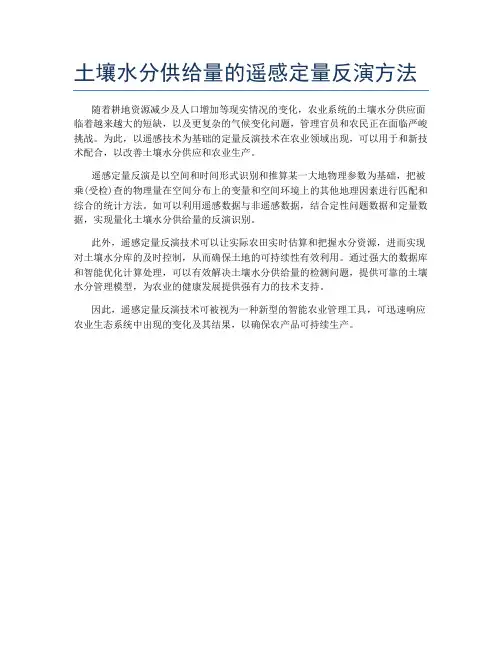
土壤水分供给量的遥感定量反演方法
随着耕地资源减少及人口增加等现实情况的变化,农业系统的土壤水分供应面临着越来越大的短缺,以及更复杂的气候变化问题,管理官员和农民正在面临严峻挑战。
为此,以遥感技术为基础的定量反演技术在农业领域出现,可以用于和新技术配合,以改善土壤水分供应和农业生产。
遥感定量反演是以空间和时间形式识别和推算某一大地物理参数为基础,把被乘(受检)查的物理量在空间分布上的变量和空间环境上的其他地理因素进行匹配和综合的统计方法。
如可以利用遥感数据与非遥感数据,结合定性问题数据和定量数据,实现量化土壤水分供给量的反演识别。
此外,遥感定量反演技术可以让实际农田实时估算和把握水分资源,进而实现对土壤水分库的及时控制,从而确保土地的可持续性有效利用。
通过强大的数据库和智能优化计算处理,可以有效解决土壤水分供给量的检测问题,提供可靠的土壤水分管理模型,为农业的健康发展提供强有力的技术支持。
因此,遥感定量反演技术可被视为一种新型的智能农业管理工具,可迅速响应农业生态系统中出现的变化及其结果,以确保农产品可持续生产。
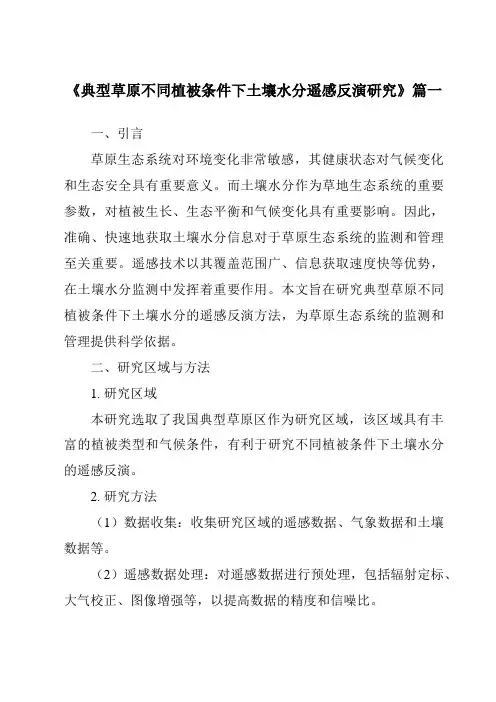
《典型草原不同植被条件下土壤水分遥感反演研究》篇一一、引言草原生态系统对环境变化非常敏感,其健康状态对气候变化和生态安全具有重要意义。
而土壤水分作为草地生态系统的重要参数,对植被生长、生态平衡和气候变化具有重要影响。
因此,准确、快速地获取土壤水分信息对于草原生态系统的监测和管理至关重要。
遥感技术以其覆盖范围广、信息获取速度快等优势,在土壤水分监测中发挥着重要作用。
本文旨在研究典型草原不同植被条件下土壤水分的遥感反演方法,为草原生态系统的监测和管理提供科学依据。
二、研究区域与方法1. 研究区域本研究选取了我国典型草原区作为研究区域,该区域具有丰富的植被类型和气候条件,有利于研究不同植被条件下土壤水分的遥感反演。
2. 研究方法(1)数据收集:收集研究区域的遥感数据、气象数据和土壤数据等。
(2)遥感数据处理:对遥感数据进行预处理,包括辐射定标、大气校正、图像增强等,以提高数据的精度和信噪比。
(3)植被指数计算:计算研究区域的植被指数,如归一化植被指数(NDVI)等,以反映植被的生长状况和覆盖度。
(4)土壤水分反演:利用遥感数据和植被指数,结合土壤水分反演模型,对研究区域的土壤水分进行反演。
(5)数据分析与处理:对反演得到的土壤水分数据进行统计分析、空间分析和时间序列分析等,以揭示不同植被条件下土壤水分的分布特征和变化规律。
三、不同植被条件下土壤水分的遥感反演1. 植被类型对土壤水分的影响不同植被类型对土壤水分的保持和利用能力不同,因此,在遥感反演中需要考虑植被类型的影响。
本研究选取了典型草原区的草地、灌木、森林等不同植被类型,分别进行土壤水分的遥感反演。
2. 遥感数据的选择与处理在遥感数据的选取上,本研究选择了不同时相、不同分辨率的卫星遥感数据,以充分反映草原生态系统的动态变化。
在数据处理上,采用了辐射定标、大气校正、图像增强等预处理方法,以提高数据的精度和信噪比。
3. 土壤水分反演模型的建立与应用本研究结合研究区域的实际情况,建立了基于遥感数据的土壤水分反演模型。
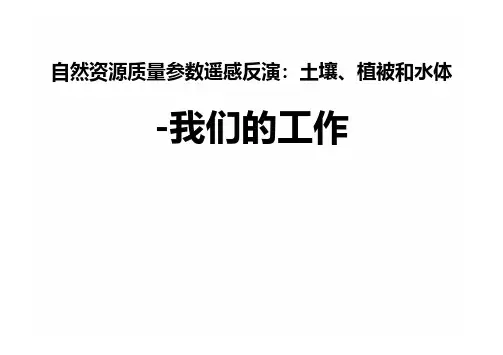
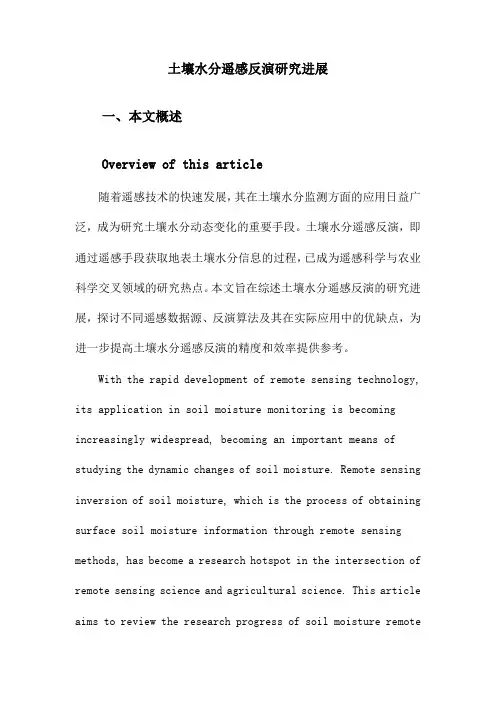
土壤水分遥感反演研究进展一、本文概述Overview of this article随着遥感技术的快速发展,其在土壤水分监测方面的应用日益广泛,成为研究土壤水分动态变化的重要手段。
土壤水分遥感反演,即通过遥感手段获取地表土壤水分信息的过程,已成为遥感科学与农业科学交叉领域的研究热点。
本文旨在综述土壤水分遥感反演的研究进展,探讨不同遥感数据源、反演算法及其在实际应用中的优缺点,为进一步提高土壤水分遥感反演的精度和效率提供参考。
With the rapid development of remote sensing technology, its application in soil moisture monitoring is becoming increasingly widespread, becoming an important means of studying the dynamic changes of soil moisture. Remote sensing inversion of soil moisture, which is the process of obtaining surface soil moisture information through remote sensing methods, has become a research hotspot in the intersection of remote sensing science and agricultural science. This article aims to review the research progress of soil moisture remotesensing inversion, explore different remote sensing data sources, inversion algorithms, and their advantages and disadvantages in practical applications, and provide reference for further improving the accuracy and efficiency of soil moisture remote sensing inversion.本文首先介绍了土壤水分遥感反演的基本原理和方法,包括遥感数据源的选择、预处理、反演算法的设计与实施等。
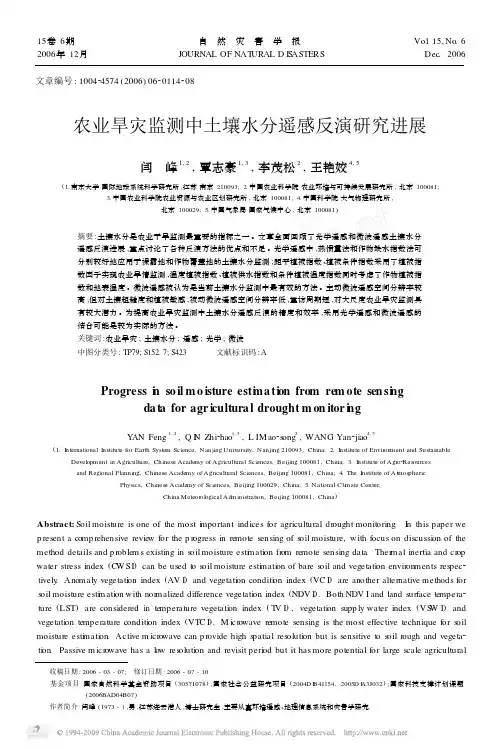
15卷6期2006年12月自 然 灾 害 学 报JOURNAL OF NAT URAL D I S ASTERS Vol .15,No .6Dec .2006收稿日期:2006-03-07; 修订日期:2006-07-10 基金项目:国家自然科学基金资助项目(30571078);国家社会公益研究项目(2004D I B 4J154,2005D I A 3J032);国家科技支撑计划课题(2006BAD04B07) 作者简介:闫峰(1973-),男,江苏连云港人,博士研究生,主要从事环境遥感、地理信息系统和灾害学研究.文章编号:100424574(2006)0620114208农业旱灾监测中土壤水分遥感反演研究进展闫 峰1,2,覃志豪1,3,李茂松2,王艳姣4,5(1.南京大学国际地球系统科学研究所,江苏南京210093; 2.中国农业科学院农业环境与可持续发展研究所,北京100081;3.中国农业科学院农业资源与农业区划研究所,北京100081;4.中国科学院大气物理研究所,北京100029; 5.中国气象局国家气候中心,北京100081)摘要:土壤水分是农业干旱监测最重要的指标之一。
文章全面回顾了光学遥感和微波遥感土壤水分遥感反演进展,重点讨论了各种反演方法的优点和不足。
光学遥感中,热惯量法和作物缺水指数法可分别较好地应用于裸露地和作物覆盖地的土壤水分监测;距平植被指数、植被条件指数采用了植被指数因子实现农业旱情监测,温度植被指数、植被供水指数和条件植被温度指数同时考虑了作物植被指数和地表温度。
微波遥感被认为是当前土壤水分监测中最有效的方法。
主动微波遥感空间分辨率较高,但对土壤粗糙度和植被敏感;被动微波遥感空间分辨率低,重访周期短,对大尺度农业旱灾监测具有较大潜力。
为提高农业旱灾监测中土壤水分遥感反演的精度和效率,采用光学遥感和微波遥感的结合可能是较为实际的方法。
关键词:农业旱灾;土壤水分;遥感;光学;微波中图分类号:TP79;S152.7;S423 文献标识码:AProgress i n so il m o isture esti m a ti on from rem ote sen si n gda t a for agr i cultura l drought m on itor i n gY AN Feng 1,2,Q I N Zhi 2hao 1,3,L IMao 2s ong 2,WANG Yan 2jiao 4,5(1.I nternati onal I nstitute for Earth Syste m Science,Nanjing University,Nanjing 210093,China; 2.I nstitute of Envir onment and SustainableDevel opment in Agriculture,Chinese Acade my of Agricultural Sciences,Beijing 100081,China; 3.I nstitute of Agr o 2Res ourcesand Regi onal Planning,Chinese Acade my of Agricultural Sciences,Beijing 100081,China; 4.The I nstitute of A t m os phericPhysics,Chinese Acade my of Sciences,Beijing 100029,China; 5.Nati onal Cli m ate Center,China Meteor ol ogical Adm inistrati on,Beijing 100081,China )Abstract:Soil moisture is one of the most i m portant indices for agricultural dr ought monit oring .I n this paper we p resent a comp rehensive revie w f or the p r ogress in re mote sensing of s oil moisture,with f ocus on discussi on of the method details and p r oble m s existing in s oil moisture esti m ati on fr o m re mote sensing data .Ther mal inertia and cr op water stress index (C W SI )can be used t o s oil moisture esti m ati on of bare s oil and vegetati on envir on ments res pec 2tively .Anomaly vegetati on index (AV I )and vegetati on conditi on index (VC I )are another alternative methods for s oil moisture esti m ati on with nor malized difference vegetati on index (NDV I ).Both NDV I and land surface te mpera 2ture (LST )are considered in te mperature vegetati on index (T V I ),vegetati on supp ly water index (VS W I )and vegetati on te mperature conditi on index (VTC I ).M icr owave re mote sensing is the most effective technique f or s oil moisture esti m ati on .Active m icr owave can p r ovide high s patial res oluti on but is sensitive t o s oil r ough and vegeta 2ti on .Passive m icr owave has a l ow res oluti on and revisit peri od but it has more potential for large scale agriculturaldr ought monit oring .I ntegrati on of op tical and m icr owave re mote sensings may be the p ractical method of dr ought monit oring in both accuracy and efficiency .Key words:agricultural dr ought;s oil moisture;re mote sensing;op tics;m icr owave农业旱灾是世界上最常见、影响最大的气候灾害,不但直接造成了粮食减产和经济损失,而且严重影响了农业的可持续发展和社会的稳定。
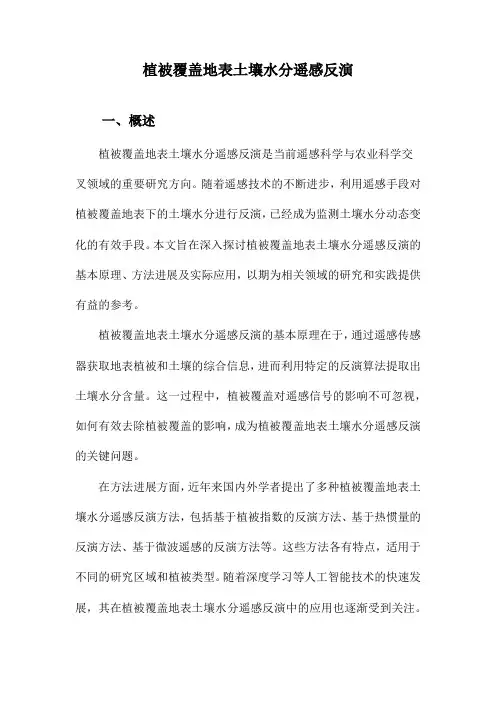
植被覆盖地表土壤水分遥感反演一、概述植被覆盖地表土壤水分遥感反演是当前遥感科学与农业科学交叉领域的重要研究方向。
随着遥感技术的不断进步,利用遥感手段对植被覆盖地表下的土壤水分进行反演,已经成为监测土壤水分动态变化的有效手段。
本文旨在深入探讨植被覆盖地表土壤水分遥感反演的基本原理、方法进展及实际应用,以期为相关领域的研究和实践提供有益的参考。
植被覆盖地表土壤水分遥感反演的基本原理在于,通过遥感传感器获取地表植被和土壤的综合信息,进而利用特定的反演算法提取出土壤水分含量。
这一过程中,植被覆盖对遥感信号的影响不可忽视,如何有效去除植被覆盖的影响,成为植被覆盖地表土壤水分遥感反演的关键问题。
在方法进展方面,近年来国内外学者提出了多种植被覆盖地表土壤水分遥感反演方法,包括基于植被指数的反演方法、基于热惯量的反演方法、基于微波遥感的反演方法等。
这些方法各有特点,适用于不同的研究区域和植被类型。
随着深度学习等人工智能技术的快速发展,其在植被覆盖地表土壤水分遥感反演中的应用也逐渐受到关注。
在实际应用方面,植被覆盖地表土壤水分遥感反演在农业、生态、环境等领域具有广泛的应用前景。
通过实时监测土壤水分状况,可以为农业生产提供科学的灌溉指导,提高水资源的利用效率也可以为生态环境监测和评估提供重要的数据支持,有助于维护生态平衡和可持续发展。
植被覆盖地表土壤水分遥感反演是一项具有重要意义的研究工作。
随着遥感技术的不断进步和反演算法的不断优化,相信这一领域的研究将会取得更加丰硕的成果。
1. 背景介绍:植被覆盖地表土壤水分的重要性及其在农业、生态和环境监测中的应用。
植被覆盖地表的土壤水分是地球水循环的重要组成部分,它直接影响着植被的生长和生态系统的平衡。
在农业领域,土壤水分是作物生长的关键因素之一,其含量和分布直接影响着作物的产量和品质。
准确获取植被覆盖地表的土壤水分信息,对于指导农业生产、优化水资源管理具有重要意义。
在生态方面,土壤水分与植被覆盖度之间存在着密切的相互作用关系。
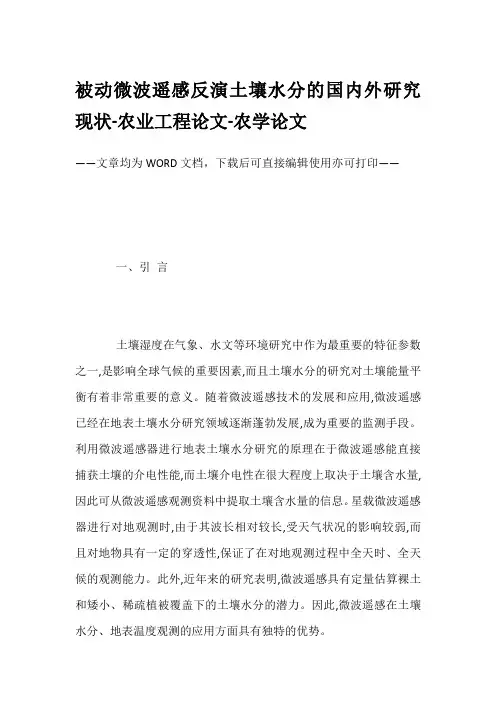
被动微波遥感反演土壤水分的国内外研究现状-农业工程论文-农学论文——文章均为WORD文档,下载后可直接编辑使用亦可打印——一、引言土壤湿度在气象、水文等环境研究中作为最重要的特征参数之一,是影响全球气候的重要因素,而且土壤水分的研究对土壤能量平衡有着非常重要的意义。
随着微波遥感技术的发展和应用,微波遥感已经在地表土壤水分研究领域逐渐蓬勃发展,成为重要的监测手段。
利用微波遥感器进行地表土壤水分研究的原理在于微波遥感能直接捕获土壤的介电性能,而土壤介电性在很大程度上取决于土壤含水量,因此可从微波遥感观测资料中提取土壤含水量的信息。
星载微波遥感器进行对地观测时,由于其波长相对较长,受天气状况的影响较弱,而且对地物具有一定的穿透性,保证了在对地观测过程中全天时、全天候的观测能力。
此外,近年来的研究表明,微波遥感具有定量估算裸土和矮小、稀疏植被覆盖下的土壤水分的潜力。
因此,微波遥感在土壤水分、地表温度观测的应用方面具有独特的优势。
二、国内外研究进展目前国内外利用遥感监测土壤湿度的方法主要有微波遥感、红外遥感、植被供水指数、数据同化等方法。
红外遥感和卫星监测都会因天气的影响产生误差,且卫星遥感也会有自然条件的局限。
而微波遥感技术不受天气影响,微波辐射计的被动微波方法时间分辨率高,费用低,而且能针对不同的地质进行检测。
在微波遥感反演土壤水分的研究中,均未对频繁变化的土壤表面结构因素予以充分考虑,但土壤粗糙度正是制约土壤水分遥感精度的重要因素,由于自然地表往往都是不平坦的,因此如何减弱地表粗糙度对反演精度的影响一直是微波遥感反演土壤水分研究中的重点。
三、试验方案设计1. 试验设备试验所采用的微波辐射计是由中科院东北地理所(长春) 设计并研制的,本次试验所采用的辐射计波段为 C 波段(频率 6.6 GHz,波长4.55 cm) ,以及Ku 波段(频率13.9 GHz,波长2.16 cm) 。
2. 试验设计1) 粗糙度的改变方式是将通过手工制作的带有不同尺寸尖劈状的硬泡沫板的尖劈处按均匀的力度插入土中,并使其均匀分布于土壤表面所有位置。
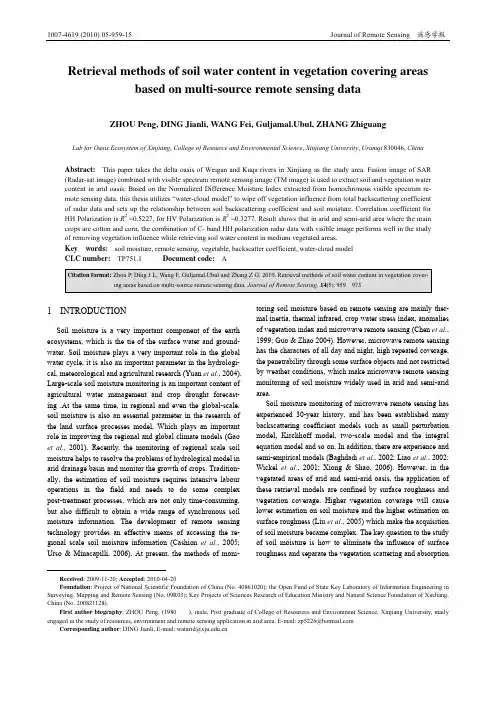
1007-4619 (2010) 05-959-15 Journal of Remote Sensing 遥感学报Received : 2009-11-20; Accepted : 2010-04-20Foundation : Project of National Scientific Foundation of China (No. 40861020); the Open Fund of State Key Laboratory of Information Engineering in Surveying, Mapping and Remote Sensing (No. 09R03); Key Projects of Sciences Research of Education Ministry and Natural Science Foundation of XinJiang, China (No. 200821128).First author biography : ZHOU Peng, (1980— ), male, Post graduate of College of Resources and Environment Science, Xinjiang University, maily engaged in the study of resources, environment and remote sensing application in arid area. E-mail: zp5226@Corresponding author : DING Jianli, E-mail: watarid@Retrieval methods of soil water content in vegetation covering areasbased on multi-source remote sensing dataZHOU Peng, DING Jianli, WANG Fei, Guljamal.Ubul, ZHANG ZhiguangLab for Oasis Ecosystem of Xinjiang , College of Resource and Environmental Science , Xinjiang University , Urumqi 830046, ChinaAbstract: This paper takes the delta oasis of Weigan and Kuqa rivers in Xinjiang as the study area. Fusion image of SAR(Radar-sat image) combined with visible spectrum remote sensing image (TM image) is used to extract soil and vegetation water content in arid oasis. Based on the Normalized Difference Moisture Index extracted from homochronous visible spectrum re-mote sensing data, this thesis utilizes “water-cloud model” to wipe off vegetation influence from total backscattering coefficient of radar data and sets up the relationship between soil backscattering coefficient and soil moisture. Correlation coefficient for HH Polarization is R 2 =0.5227, for HV Polarization is R 2 =0.3277. Result shows that in arid and semi-arid area where the main crops are cotton and corn, the combination of C- band HH polarization radar data with visible image performs well in the study of removing vegetation influence while retrieving soil water content in medium vegetated areas.Key words: soil moisture, remote sensing, vegetable, backscatter coefficient, water-cloud model CLC number: TP751.1 Document code: A1 INTRODUCTIONSoil moisture is a very important component of the earthecosystems, which is the tie of the surface water and ground-water. Soil moisture plays a very important role in the global water cycle, it is also an important parameter in the hydrologi-cal, meteorological and agricultural research (Yuan et al., 2004). Large-scale soil moisture monitoring is an important content of agricultural water management and crop drought forecast-ing .At the same time, in regional and even the global-scale, soil moisture is also an essential parameter in the research of the land surface processes model, Which plays an important role in improving the regional and global climate models (Gao et al., 2001). Recently, the monitoring of regional scale soil moisture helps to resolve the problems of hydrological model in arid drainage basin and monitor the growth of crops. Tradition-ally, the estimation of soil moisture requires intensive labour operations in the field and needs to do some complex post-treatment processes, which are not only time-consuming, but also difficult to obtain a wide range of synchronous soil moisture information. The development of remote sensing technology provides an effective means of accessing the re-gional scale soil moisture information (Cashion et al., 2005; Urso & Minacapilli, 2006). At present, the methods of moni-toring soil moisture based on remote sensing are mainly ther-mal inertia, thermal infrared, crop water stress index, anomalies of vegetation index and microwave remote sensing (Chen et al., 1999; Guo & Zhao 2004). However, microwave remote sensing has the characters of all day and night, high repeated coverage, the penetrability through some surface objects and not restricted by weather conditions, which make microwave remote sensing monitoring of soil moisture widely used in arid and semi-arid area.Soil moisture monitoring of microwave remote sensing has experienced 30-year history, and has been established many backscattering coefficient models such as small perturbation model, Kirchhoff model, two-scale model and the integral equation model and so on. In addition, there are experience and semi-empirical models (Baghdadi et al., 2002; Liao et al., 2002; Wickel et al., 2001; Xiong & Shao, 2006). However, in the vegetated areas of arid and semi-arid oasis, the application of these retrieval models are confined by surface roughness and vegetation coverage. Higher vegetation coverage will cause lower estimation on soil moisture and the higher estimation on surface roughness (Liu et al., 2005) which make the acquisition of soil moisture became complex. The key question to the study of soil moisture is how to eliminate the influence of surface roughness and separate the vegetation scattering and absorption960Journal of Remote Sensing 遥感学报 2010, 14(5)from the soil moisture. In these models, vegetation water con-tent (VWC) is an important parameter. As it is very difficult tomeasure the parameter in the field, people usually use the opti-cal image to predict and then establish the relationship between normalized difference moisture index (NDMI) and VWC. Based on the use of optical image data, this paper uses NDMI to estimate the study area’s vegetation water content, then, em-ploys multi-polarization satellite-based radar data together with microwave scattering Water-Cloud Model eliminating the im-pact of the vegetation layer and isolating the contributions of vegetation scattering and absorption from the total backscat-tering coefficient, Which is the research on the estimation of surface soil moisture in vegetated areas in arid oasis.2 STUDY AREA AND DATA SOURCE 2.1 Status of study areaThe study area in this paper locates in the north of Tarim Basin, the lower reaches of Weigan and Kuqa Rivers, the mid-dle of Tianshan and the north of Taklamagan desert. The aver-age elevation is 920—1100m, which belongs to landwarm-temperate zone extreme arid climate. The average annual evaporation is 2420.23 mm, the average annual precipitation is 43.1mm, and the ratio of evaporation to precipitation is about 54 to 1. The image range of study area is that the coordinate of east longitude is from 82º15′ to 82º53′ and north latitude is from 41º15′ to 42º36′, which is confirmed according to the samples in field. Farm belt is dominant in study area, and the types of vegetation is not complex and is mainly composed of cotton (55%) and corn (15%) combining with other halophytes shrubs and salt secretion plants such as Tamarix, bulrush, Populus eupfratica and Alhagi sparsifolia Shap.2.2 Status of satellite dataRadarsat-2 satellite was successfully launched in December 14, 2007 at space launch base in Kazakhstan's Baikonur, it can provide 11 kinds of beam patterns, the highest resolution is 3m, the maximum imaging width is 500 km, and the maximum data rate is 445.4Mb/s, the range of incidence angle is 10°—60°. The C-Band can effectively extract soil moisture of 0—5cm soil layer. The primary parameters of RADARSAT-2 System are showed in Table 1.Table 1 Primary parameters of RADARSAT-2 systemCarrier frequency Polarization mode Bandwidth/MHz Antenna dimension/m 2Antenna quality/kgActive antenna Proposed isolation/dB C-Band (5.405GHz) HH, HV VH, VV11.6, 17.3, 30, 50, 10015×1.5750C-Band T/R>25The multi-polarization data of Radarsat-2 in September 10,2008 is chosen in this study, and the polarization is HH and HV. The homochronous visible data is Landsat-5 TM data which includes mid-infrared and near-infrared band for calculating NDMI. The image of study area is as follows:Fig. 1Polarization composite image of RADARSAT 2 HH/HVFig. 2 RGB composite image of Landsat5 TM 5432.3 Collection and analysis of samplesIn this study, Landsat-5 TM data obtained in Sep 27, 2007 is used as a reference map to choose the typical samples in the middle and the southwest of the oasis of Weigan and Kuqa rivers combining with GPS positioning technology. Sampling points are selected regularly distribution as much as possible and com-prehensive considering of the local soil, vegetation type and other factors. Sampling time is from sep 16, 2008 to sep 26, 2008 and there are 30 located sampling points in this study. Set 5 sampling points as Plum-shape in the range of 30m of each located points and profile mining each sample points and the profiles of each sample are 0—5cm. Borrow these soil samples and vegetation samples around of the soil sample dots back to laboratories, and dry them with the weighing method to obtain the soil avoirdupois moisture and vegetation water content.3 PREPROCESSINGImage data pre-processing mainly includes image registra-tion, geometric correction, noise reduction and color enhance-ment and so on. As it is need to find out the relationship be-tween normalized difference moisture index (NDMI) and vege-tation water content (VWC), the atmospheric correction of TM data is absolutely necessary. The level of SAR image data ob-tained is SLC, so it should do noise reduction, radiometric cali-bration and geometric correction. 3.1 Optical image processingIn order to keep the aboriginality, the image only did at-ZHOU Peng et al .: Retrieval methods of soil water content in vegetation covering areas based on multi-source remote sensing data 961mospheric correction and geometric correction neglecting otherpre-processing, which assure the objectivity of estimation. Be-cause of the impacts of atmosphere on visible-near-infrared and thermal infrared are different, it is necessary to separately carry out atmospheric correction using 6S model (Liu & Zhao, 2002). While geometric correction was performed to do multinomial correction of TM image using ground control points.3.2 Radar image processing 3.2.1 Radiometric calibrationAs the radiometric error caused by the difference of the dis-tance between ground scattering cell and radar, it is need to becorrected.Radiometric calibration equations is :20sin()nD Kσα= (1) where, D n 2 is the pixel intensity value, α is the radar incidence angle of the target location, K is the absolute calibration factor of the image. The values of K and α are obtained from the header files. SIGMA parameter correction is selected. Figure out the distance orientational incident angle of every pixels, then RADARSAT-2 satellite image data is changed to backscattering coefficient using the below calibration expres-sion:212()10log()/10log(sin())n D A A σθθ°=++ (2) where, D n is the gray-level value of radar image, A 1, A 2 are automatic gain control coefficient of radar system, θ is the dis-tance orientational incident angle of every pixels.3.2.2 Noise treatmentThe interrelated treatment in the processing of Radar-sat imaging causes a large number of spots (Speckle), which pro-duce an obstacle on feature extraction, so the noise treatment is used to eliminate the impact. After several rounds of test analy-sis, 5 × 5 enhanced Lee filter to the original SAR image has the best filtering effect, which can eliminate the most spots. 3.2.3 Geometric calibrationIn this thesis, the study area is flat, so cubic polynomial is selected as the correction method.4 RETRIEVAL OF SOIL MOISTURE CONTENTIN VEGETATED AREASThe vegetation water content (VWC) is extracted based on a choice of appropriate microwave scattering model. As it is definitely difficult to do large-scale area survey and extracting, which also definitely destroys vegetation, this paper uses Landsat-5 TM data to figure out normalized difference moisture index (NDMI) and find out the relationship between NDMI and VWC, then validates the vegetation water content. With that, multi-polarization satellite-based radar data together with mi-crowave scattering water-cloud model are employed eliminat-ing the impact of the vegetation layer on radar backscattering and finally retrieves the soil water content of study area.4.1 Choice of microwave scattering model of soil moisturecontent in vegetated areasIn the study on soil moisture of Microwave remote sensing,vegetated areas will interfere with soilbacks cattering signal. Therefore, it is necessary to establish a rational vegetation scat-tering model and remove the impact of the vegetation in soil moisture retrieval algorithm. A lot of foreign scholars havebeen studied on vegetation scattering model: a group of Michi-gan State University in USA, proposed “MIMICS” Model in 1990, MIMICS Model (Fung et al., 1992)was established fortall plants such as arbor, it took into account three levels ofvegetation canopy, tree trunks and the bottom surface ,whichmore realistically simulate the surface microwave backscat-tering. In 1978, Attma, Ulaby etc. using crops as the research object, proposed “Water-Cloud” model. “Water-Cloud” model assumes vegetation as homogeneous scatter and ignores themultiple scattering between vegetation layer and the surface. The overall backscattering of vegetation coverage area is sim-ply divided into two parts, namely, the direct reflection by the vegetation back scattering and the ground backscattering after the double attenuation of crop. Because there are mostly crops and other low vegetation in study area, “Water-Cloud” model is simple and practical. Be-sides, it uses very few parameters.The model is expressed as follows:0020can veg soil ()()()()σθσθγθσθ=+ (3)where, 0can()σθ is the total radar backscattering coefficient in vegetated areas, 0veg ()σθ is the direct backscattering coeffi-cient of vegetation layer, 0soil ()σθ is the direct backscatteringcoefficient of surface, γ2(θ) is the double attenuation factor of radar wave penetrating crops, where: 02veg veg ()cos()(1())A m σθθγθ=⋅⋅⋅− (4)22pp veg ()exp(2sec())Bm γθθ=− (5)In the expressions above, A and B are parameters depending on the type of vegetation which can be respectively obtained through regression arithmetic after the utilization of MIMICS model to simulate the surface parameters. m veg is vegetation water content (kg/m 3), θ is the angle of incidence of radar wave.4.2 Extracting of characteristic parameters and vegetationwater content estimationThe vegetation water content is defined as the water content of plants per unit and per area. As a significant input parameter of Water-Cloud model, VWC performs very crucial effect on the retrieval of soil moisture in vegetated areas (Liu et al., 2008). Now, the study of the regional retrieval of VWC using visible image has been already mature, and the relativity estab-lished between spectrum index and VWC is high(Jackson et al.,962Journal of Remote Sensing 遥感学报 2010, 14(5)2004; Rosnay et al., 2006; Wang et al., 2008). So, this study uses visible remote sensing to retrieve and field survey data ofsamples to validate the VWC in study area. In view of the spec-trum characteristic of soil, vegetation and water between 0.8 to1.7μm, Landsat5 TM(sep 16,2008) homochronous with fieldsurvey date is chose which includes near- infrared band 4(0.76μm)and mid-infrared band 5(1.55μm). The spectrumbandwidths are respectively 25 nm and 20 nm. According to the characteristic of vegetation that it has higher reflectivity in near-infrared band and lower reflectivity in mid-infrared band because of the absorbing effect of leave’s water content, NDMI (Gao,1996; ZARCO-TEJADA et al., 2003)is applied to extractvegetation water content information. As the vegetation instudy area are most cotton and other low salt secretion plants,based on relevant research (Chen et al., 2005), the equation isshowed as expressions 6, while expressions 7 is established to gain VWC according to the relationship between vegetationwater content of field survey and NDMI. NDMI (NIR MIR)/(NIR MIR)=−+ (6) VWC 2.15NDMI 0.32=+ (7) There are rivers, lakes and reservoirs in study area whichdisturb the extracting of vegetation water content. So, the ef-fects of these water bodies must be removed in the process of the retrieval work. This paper uses MNDWI index (Xu, 2008)which is improved a little according as the regional circs toextract water body information, the equation is as follows:MNDWI (1+0.5)(GREEN-MIR)/(GREEN+MIR)= (8) After that, masking the original image and the water body effects are removed. Analysis and validation indicate that NDMI performs well in the retrieval of vegetation water con-tent.4.3 Calculating of backscattering in vegetated areasThe soil moisture estimation of initiative microwave remotesensing is mainly affected by vegetation coverage and surface roughness. The soil backscattering in vegetated area is com-posed of body scattering from vegetation, surface scattering from earth and the multiple scattering between vegetation layer and the surface. These factors are taken into account in the estimation of soil moisture content (Li et al., 2002). As the hypsography in study area is flat, and mostly is covered by low plants, vegetation is considered seriously while the effect of surface roughness is not taken into account when calculating the soil backscattering coefficient.In the study of soil moisture estimation in vegetated area, it is necessary to use “Water-Cloud” model to remove the contri-bution of vegetation in the backscattering. Parameters A and B are experience constants and they are changed by regional limit. A relatively mature method is applied to calibrate the parame-ters (Chen et al., 2007; Gao et al., 2008). Firstly, Water-Cloud and MIMICS model are used to simulate the backscattering coefficient of vegetated area then obtain the surface direct scat-tering and the variational relationship between surface scatter-ing and incident angle. Follow that, parameters of the dominate plants in study area is showed in Table 2. Based on the simu-lating results, calibrate the vegetation parameters A and B men-tioned in Water-Cloud model through non-linear least squares method.Table 2 Parameters input to MIMICS modelClass Parameters ValueFrequency /GHz 5.4Sensor Polarization mode HH/HVWater content 0.17 Root mean square height /cm 0.817 Land surface Correlative length /cm 7.528 Water content 0.39Radius /cm 2.6 Thickness /cm 0.04 LeavesHeight /m 0.9 Radius /cm 0.3 Length /cm 21Branch Density /m 38.6Climate Temperature /(°)22 After the analysis of regression, A is 0.0019 and B is 0.137. In term of Eq.(4) and Eq.(5), bare soil backscattering is ac-quired with Water-Cloud model removing the vegetation influ-ence, the expressions are as follows:02veg veg ()0.0019cos()(1())m σθθγθ=×××− (9)2veg ()exp(20.137sec())m γθθ=−× (10)00veg 0soil 2()()()()σθσθσθγθ−=(11)The total backscattering coefficient of surface can be calcu-lated from Eq. (2) and soil backscattering coefficient after eliminating vegetation effect is got from Eq.(11). In order to clear up the connection between HH and HV , there separately does a correlation analysis of backscattering coefficients of HH and HV before and after eliminating vegetation effect. Consid-ering that the change of soil moisture can not be reflected effec-tively from radar backscattering coefficient in some high vege-tated area, ambiguous dots are canceled in the analysis, results show:Fig. 3 and Fig. 4 indicate that: whatever before or after eliminating vegetation effect, correlation coefficients of HHFig. 3 Simulated curve between the backscattering coefficient of HHand HV polarization before eliminating vegetation effectZHOU Peng et al.: Retrieval methods of soil water content in vegetation covering areas based on multi-source remote sensing data 963Fig. 4 Simulated curve between the backscattering coefficient of HHand HV polarization after eliminating vegetation effectand HV polarization backscattering coefficients are all very lowwhich are respectively 0.2534 and 0.2884. Therefore, the nextwork is to discuss the soil water content retrieval of HH, HVpolarization.4.4 Analysis of sample dots dataIn order to analyze the effect factors of backscatteringcoefficient in vegetation coverage area, we got 30 sample dotsfrom field survey which include water content in the soil layerof 0—5cm and the coordinates of these samples. Backscatteringcoefficient and water content of soil of the samples are showedin Table 3. According to the data in Table 3, respectively ana-lyze the relationship between HH, HV polarization backscat-tering coefficient and water content of soil before and afterremoving vegetation influence and discuss the impact tobackscattering coefficient of vegetation.Table 3 Backscattering coefficient and water content of soilSamples HH polarization/dBHV polarization/dBWater content in 5cm%C 1 −13.2507 −17.7713 5.1470 C 2 −10.7600−19.8877 4.9754 C 3 −11.5946−18.4416 5.0036 C 4 −11.3997−17.61538.4150 C 5 −12.2587−18.45157.6217 C 6 −12.5959−15.775814.7993 C 7 −11.5938−17.819411.7455 C 8 −10.7801−17.229313.1799 C 9 −14.3954−19.3163 3.6656 C 10 −9.6117−21.013910.7864 C 11 −12.8598−19.3812 4.3598 C 12 −15.9316−17.5230 3.2380 C 13 −14.9207−18.9558 2.2208 C 14 −9.7728−16.767318.8682 C 15 −7.8132−16.776320.1818 C 16 −13.1535−17.999312.1819 C 17 −12.8540−19.6966 4.9591 C 18 −14.1582−16.0084 4.1625 C 19 −13.8883−19.6414 4.0697 C 20 −13.5933−20.4478 4.8147 C 21 −12.8223−22.6523 3.1433 C 22 −10.5719−29.8080 1.1135 C 23 −9.2110−22.3394 6.7921 C 24 −8.8493−22.076813.1973 C 25 −12.9640−22.8122 1.3152 C 26 −11.4630−18.05148.5359 C 27 −15.0914−14.8482 2.0410 C 28 −11.0910−20.98437.2859 C 29 −9.4889−19.748315.7987 C 30 −8.8780−19.678310.3772Obtain the corresponding backscattering coefficient of the 30 samples in the image according as their coordinates, the relationship between before and after removing vegetation in-fluence of HH, HV polarization backscattering coefficient dis-played in Fig. 5.Fig. 5 Graph of relationship between HH, HV polarizationbackscattering coefficient(a) HH polarization; (b) HV polarizationIt is showed in Fig. 5 that, HH, HV polarization backscat-tering coefficient are becoming attenuation when separating the scattering and absorbing of vegetation using water-cloud model. The change of HH polarization data is thin, the reason is that the cropland of these samples is over the irrigation time and the evaporation is high, which results in lower water content of leaves and rhizome. Thus, the impact to scattering and absorb-ing of vegetation is tiny. HV polarization data is influenced by the scattering of plant canopy and branch. The study area is mostly covered by low crops and shrub. It is supposed that the vegetation is a orbicular scattering body covered with the earth’s surface and ignoring its size, figure and the distributing character of the orientation, which results in a tiny change after removing the influence of vegetation.The influencing analysis of vegetation on backscattering co-efficient 0soil()σθof bare soil:The backscattering coefficient of vegetation 0veg()σθ is acquired from Water-Cloud model, then the contribution of vegetation’s scattering and absorbing can be separated from the total backscattering of radar, and then the backscattering coeffi-cient 0soil()σθ of bare soil is obtained. The relationship be-tween HH, HV polarization backscattering coefficient and soil water content before and after eliminating vegetation effect are respectively showed in Fig. 6 and Fig. 7.964Journal of Remote Sensing 遥感学报 2010, 14(5)Fig. 6 Scatter plot of HH, HV polarization backscattering coefficient and soil water content before eliminating vegetation effect(a) HH polarization; (b) HV polarizationFig. 7 Scatter plot of HH, HV polarization backscattering coefficient and soil water content after eliminating vegetation effect(a) HH polarization; (b) HV polarizationFig. 6 and Fig. 7 illustrate the correlation coefficient of HH, HV polarization backscattering coefficient and soil water con-tent before eliminating vegetation effect are respectively 0.3769 and 0.1919,while them rise to 0.5227 and 0.3277 with the use of Water-Cloud Model after eliminating vegetation effect. Therefore, the relativity of soil backscattering coefficient and soil water content is increasing while eliminating the influence of vegetation. Research indicated HH polarization is muchmore sensitive to soil water content (Bao et al., 2006), data in this paper validate that HH polarization combining with Wa-ter-Cloud Model performs well in the separation of vegetation’s scattering and absorbing from the total backscattering of soil. Based on the above conclusion, establishing the connection model of soil water content and HH polarization backscattering coefficient, the regress equation is as follows:Water5=112.91e 0.1906δ (R 2=0.5227,n =30) (12)Use the Eq. (12) to retrieve the samples’ soil water content,results is as Fig. 8.Fig. 8 Soil water content mapField survey shows some of the river ways inside of the oa-sis are dry. The top left corner of the image is oasis-desertecotone, where the soil water content is less than 8%, as the vegetation cover area is out of the irrigating time, the soil water content are mostly between 7% and 15%, and only the soil water content of a hand of marsh are a little higher. The results of field survey are consistent with the detection of the soil moisture.5 CONCLUSION AND DISCUSSIONIn this paper, a case study is the Delta oasis of Weigan and Kuqa rivers in the Xinjiang where provided with predominance of terrain characteristic. Expert the advantages of initiative microwave remote sensing Radarsat-2 data and visible remotesensing TM data to extract water content. Firstly, using TM datato extract water content of plant, then combining with Wa-ter-Cloud Model to eliminate the impact of vegetation to back-scattering of soil, finally, simulating the relationship between backscattering coefficient and soil water content and validating and analysis the results, conclusions show:(1) Comparing with soil water content data and backscat-tering coefficient of SAR image, visible data combing with radar data performs well to extract the information of vegeta-tion and soil water content, and HH polarization backscattering coefficient is much closer to the change of soil water content. (2) Years’ difference has influence on character of vegetation. Although the year and the month of the soil water content data from field survey are contemporaneous with the image, the days are not, Which are likely to lead to differences of waterZHOU Peng et al.: Retrieval methods of soil water content in vegetation covering areas based on multi-source remote sensing data 965ingredient, leaves and rhizome water content and soil water content and them will disturb the extracting of plant water con-tent. The continuing study can try to relatively transform the spectrum data and construct some index to eliminate the effect of exoteric factors.(3) The hypsography in study area is flatness, and mostly covered by low plants, accordingly, the effect of surface roughness is not taken into account when calculating the soil water content. While in practical application the impact of sur-face roughness to radar echo is not neglected, which is a prob-lem in this research. The continuing work is to add the analysis of the influence of surface roughness.Presently, it has been a big progress of retrieving soil water content using microwave remote sensing, but it is also difficult to establish a universal arithmetic to retrieve soil moisture, which is mainly induced by the complexity of factors effecting microwave backscattering coefficient such as surface roughness and vegetation coverage and the uncertainty of the relationship between these factors. So how to eliminate these effects is the emphases of the continuing work and in latter research multi–source data should be comprehensively utilized and combining with kinds of retrieval model to found a regional initiative microwave remote sensing soil water content retrieval arithmetic in order to improve the precision of soil moisture inversion.REFERENCESBaghdadi N, King C and Clumsy A. 2002. An empirical calibration of the integral equation model based. SAR data ,soil moisture and surface roughness measurement over Bare soils. International Journal of Remote Sensing, 23(20): 4325—4340Bao Y S, Liu L Y, Wang J H and Li X W. 2006. Estimation of soil water content and wheat coverage with ASAR image. Journal of Remote Sensing, 10(3): 263—271Cashion J,Lakshmi V and Bosch D.2005.Microwave remote sensing of soil moisture:evaluation of the TRMM microwave imager(TMI) satellite for the Little River Watershed Tifton,Georgia. Journal of Hydrology, 307: 243—253Chen D Y, Huang J F and Jackson T J. 2005. Vegetation water content estimation for corn and soybeans using spectral indices derived from MODIS near-and short-wave infrared bands. Remote Sensing of Environment,98: 225—236Chen H L and Mao L X.1999. A review: theories, methods and devel-opment on soil moisture monitoring by remote sensing. Remote Sensing Technology and Application, 14(2): 55—65Chen Q, Li Z, Wang L and Wei X L. 2007. The study of estimating soil moisture using ERS wind scatterometer. Journal of Remote Sens-ing, 11(6): 803—810Fung A K, Li Z Q and Chen K S. 1992. Backscattering from a randomly rough dielectric surface. IEEE Transactions on Geoscience and Remote Sensing, 30(2): 356—369Gao B C. 1996. NDWI-A normalized difference water index for remote sensing of vegetation liquid water from space. Remote Sensing of Environment, 58: 257—266 Gao F, Wang J M, Sun C Q and Wen J. 2001. Advances in study on microwave remote sensing of soil moisture. Remote Sensing Technology and Application, 16(2): 97—102Gao S, Niu Z and Liu C Z. 2008. The estimation of tropical plantation forest leaf area index based on Radarsat SAR data. Remote Sens-ing for Land & resources, 78(4): 35—38Guo G M and Zhao B R. 2004. Monitoring soil moisture content with MODIS data.Soils, 36(2): 219—221Jackson T J, Chen D and Cosh M. 2004. Vegetation water content map-ping using Landsat data derived normalized difference water index for corn and soybeans. Remote Sensing of Environment, 92: 475—482Liao J J, Guo H D, Shao Y, LI X W and Veneziani N. 2002. Method and model of surface feature detection in arid to Semi-arid Area Using SAR Interferometry. Journal of Remote Sensing, 6(6): 431—434Li Z, Guo H D and Shi J C. 2002. Measuring the change of soil mois-ture with vege tation cover integration passive and active micro-wave data. Journal of Remote Sensing, 6(6): 481—484Liu W X,Liu X L and Wang J.2008.Romote sensing retrieval of soil moisture using ENVISAT-ASAR and MODIS images in vegetated areas of Huanan. Agricultural Research in the Arid Areas, 26(3): 39—43Liu W, Shi J C and Wang J M. 2005. Applying the decomposition tech-nique in vegetated surface to estimate soil moisture by multi- temporal measurements. Remote Sensing Information, (4): 3—6 Liu Z H and Zhao Y S.2002. The application study of MODTRAN and 6S model on atmospheric correction of MODIS image. Journal of Remote Sensing, 6: 217—222Rosnay P D, Calvet J C and Kerr Y. 2006.SMOSREX:A long term field campaign experiment for soil moisture and land surface processes remote sensing. Remote Sensing of Environment, (102): 377—389 Urso G D and Minacapilli M. 2006. A semi-empirical approach for surface soil water content estimation from radar data without a-priori information on surface roughness. Journal of Hydrology, 321: 297—310Wang J and Xu R S. 2008.Methods and research developments for retrival of vegetable water content by remote sensing. Remote Sensing Information, (1): 100—105Wickel A J, Jackson T J and Wood E F. 2001. Multitemporal monitoring of soil moisture with radarsat SAR during the 1997 Southern Great Plains hydrology experiment. International Journal of Re-mote Sensing, 22(8): 1571—1583Xiong W C and Shao Y. 2006. Applying multi-temporal synthetic aper-ture radar(SAR) to evaluating soil-water and salt content based on IEM in arid areas. Journal of Remote Sensing, 10(1): 111—117Xu H Q. 2008. Comment on the enhanced water index(EWI): a discus-sion on the creation of a water index. Geo-Information Science, 10(6): 777—780Yuan W, Li Z Q and Liu N. 2004. Analysis of data sets with different microwave remote sensing mode in soil moisture retrieval. Engi-neering Science, 6(6): 50—56Zarco-Tejada P J, Rueda C A and Ustin S L. 2003.Water content esti-mation in vegetation with MODIS reflectance data and model in-version methods. Remote Sensing of Environment, 85: 109—124。
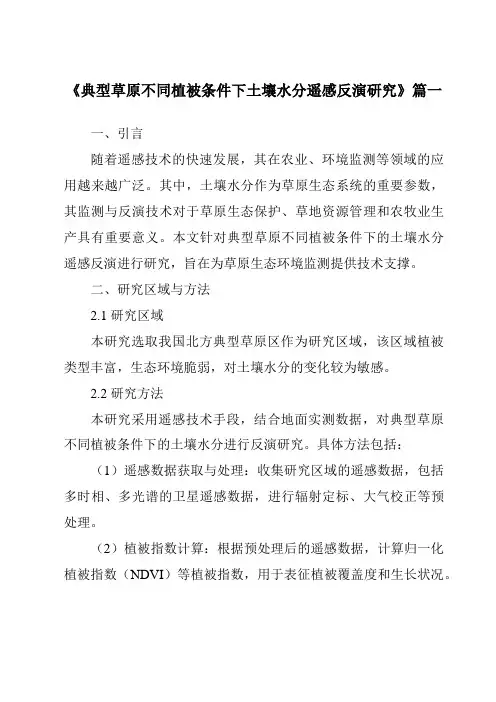
《典型草原不同植被条件下土壤水分遥感反演研究》篇一一、引言随着遥感技术的快速发展,其在农业、环境监测等领域的应用越来越广泛。
其中,土壤水分作为草原生态系统的重要参数,其监测与反演技术对于草原生态保护、草地资源管理和农牧业生产具有重要意义。
本文针对典型草原不同植被条件下的土壤水分遥感反演进行研究,旨在为草原生态环境监测提供技术支撑。
二、研究区域与方法2.1 研究区域本研究选取我国北方典型草原区作为研究区域,该区域植被类型丰富,生态环境脆弱,对土壤水分的变化较为敏感。
2.2 研究方法本研究采用遥感技术手段,结合地面实测数据,对典型草原不同植被条件下的土壤水分进行反演研究。
具体方法包括:(1)遥感数据获取与处理:收集研究区域的遥感数据,包括多时相、多光谱的卫星遥感数据,进行辐射定标、大气校正等预处理。
(2)植被指数计算:根据预处理后的遥感数据,计算归一化植被指数(NDVI)等植被指数,用于表征植被覆盖度和生长状况。
(3)土壤水分反演模型构建:结合地面实测土壤水分数据,构建土壤水分反演模型,包括统计模型、物理模型和机器学习模型等。
(4)不同植被条件下的土壤水分反演:根据构建的反演模型,对不同植被条件下的土壤水分进行反演,分析土壤水分的时空分布规律和变化趋势。
三、不同植被条件下的土壤水分反演结果3.1 草地类型对土壤水分的影响研究发现在草地类型对土壤水分的影响显著。
草地类型主要包括草原、草甸、荒漠草原等。
不同草地类型的植被覆盖度、根系分布、土壤类型等均存在差异,导致土壤水分的分布和变化规律也不同。
通过遥感反演技术,可以有效地监测不同草地类型的土壤水分状况,为草原生态保护和草地资源管理提供科学依据。
3.2 季节变化对土壤水分的影响季节变化对土壤水分的影响也不可忽视。
春季和夏季是草原生长的主要时期,植被覆盖度较高,土壤水分相对较充足;而秋季和冬季,草原生长减缓或进入休眠期,植被覆盖度降低,土壤水分相对减少。
通过遥感反演技术,可以实时监测季节变化对土壤水分的影响,为农牧业生产提供决策支持。
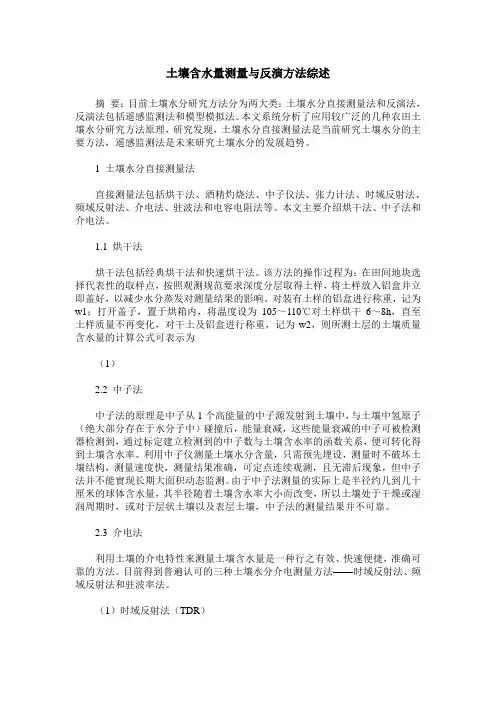
土壤含水量测量与反演方法综述摘要:目前土壤水分研究方法分为两大类:土壤水分直接测量法和反演法,反演法包括遥感监测法和模型模拟法。
本文系统分析了应用较广泛的几种农田土壤水分研究方法原理,研究发现,土壤水分直接测量法是当前研究土壤水分的主要方法,遥感监测法是未来研究土壤水分的发展趋势。
1 土壤水分直接测量法直接测量法包括烘干法、酒精灼烧法、中子仪法、张力计法、时域反射法、频域反射法、介电法、驻波法和电容电阻法等。
本文主要介绍烘干法、中子法和介电法。
1.1 烘干法烘干法包括经典烘干法和快速烘干法。
该方法的操作过程为:在田间地块选择代表性的取样点,按照观测规范要求深度分层取得土样,将土样放入铝盒并立即盖好,以减少水分蒸发对测量结果的影响。
对装有土样的铝盒进行称重,记为w1;打开盖子,置于烘箱内,将温度设为105~110℃对土样烘干6~8h,直至土样质量不再变化,对干土及铝盒进行称重,记为w2,则所测土层的土壤质量含水量的计算公式可表示为(1)2.2 中子法中子法的原理是中子从1个高能量的中子源发射到土壤中,与土壤中氢原子(绝大部分存在于水分子中)碰撞后,能量衰减,这些能量衰减的中子可被检测器检测到,通过标定建立检测到的中子数与土壤含水率的函数关系,便可转化得到土壤含水率。
利用中子仪测量土壤水分含量,只需预先埋设,测量时不破坏土壤结构,测量速度快,测量结果准确,可定点连续观测,且无滞后现象,但中子法并不能實现长期大面积动态监测。
由于中子法测量的实际上是半径约几到几十厘米的球体含水量,其半径随着土壤含水率大小而改变,所以土壤处于干燥或湿润周期时,或对于层状土壤以及表层土壤,中子法的测量结果并不可靠。
2.3 介电法利用土壤的介电特性来测量土壤含水量是一种行之有效、快速便捷,准确可靠的方法。
目前得到普遍认可的三种土壤水分介电测量方法——时域反射法、频域反射法和驻波率法。
(1)时域反射法(TDR)TDR 是近年来出现的测量土壤含水量的重要仪器,是通过测量土壤中的水和其它介质介电常数之间的差异原理,并采用时域反射测试技术研制出来的仪器,具有快速、便捷和能连续观测土壤含水量的优点。
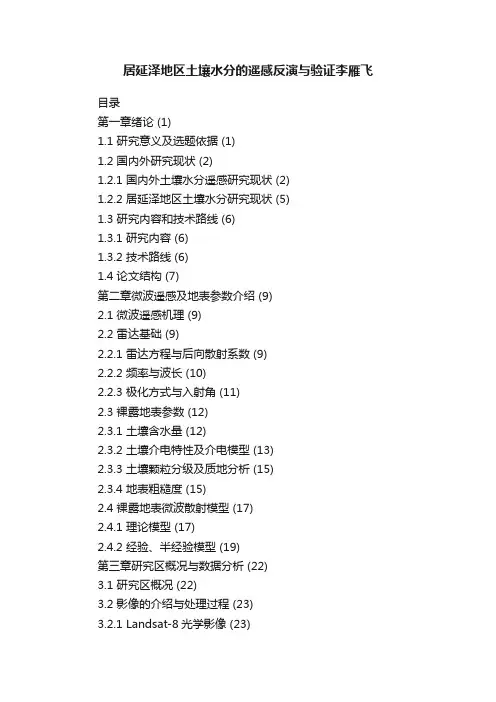
居延泽地区土壤水分的遥感反演与验证李雁飞目录第一章绪论 (1)1.1 研究意义及选题依据 (1)1.2 国内外研究现状 (2)1.2.1 国内外土壤水分遥感研究现状 (2)1.2.2 居延泽地区土壤水分研究现状 (5)1.3 研究内容和技术路线 (6)1.3.1 研究内容 (6)1.3.2 技术路线 (6)1.4 论文结构 (7)第二章微波遥感及地表参数介绍 (9)2.1 微波遥感机理 (9)2.2 雷达基础 (9)2.2.1 雷达方程与后向散射系数 (9)2.2.2 频率与波长 (10)2.2.3 极化方式与入射角 (11)2.3 裸露地表参数 (12)2.3.1 土壤含水量 (12)2.3.2 土壤介电特性及介电模型 (13)2.3.3 土壤颗粒分级及质地分析 (15)2.3.4 地表粗糙度 (15)2.4 裸露地表微波散射模型 (17)2.4.1 理论模型 (17)2.4.2 经验、半经验模型 (19)第三章研究区概况与数据分析 (22)3.1 研究区概况 (22)3.2 影像的介绍与处理过程 (23)3.2.1 Landsat-8光学影像 (23)3.2.2 Radarsat-2 雷达影像 (24)3.3 样点分布、样品采集及野外测量 (25)3.3.1 样点分布与样品采集 (25)3.3.2 研究区地表概况 (27)3.3.3 粗糙度野外测量 (29)3.4 室内实验 (30)3.4.1 体积含水量测定 (30)3.4.2 土壤粒度测定 (31)v3.4.3 粗糙度图像的处理与参数获取 (32)3.5 小结 (33)第四章AIEM模型对C波段四极化后向散射模拟 (34) 4.1 表面自相关函数的选择 (34)4.2 后向散射系数对雷达入射角的依赖关系 (35)4.2.1 土壤水分变化的影响 (35)4.2.2 均方根高度变化的影响 (36)4.2.3 相关长度变化的影响 (37)4.3 后向散射系数对土壤水分的响应 (37)4.3.1 不同入射角对土壤水分的影响 (38)4.3.2 不同均方根高度对土壤水分的影响 (38)4.3.3 不同相关长度对土壤水分的响应 (39)4.4 后向散射系数对地表粗糙度的响应 (40)4.4.1 后向散射系数对均方根高度的响应 (40)4.4.2 后向散射系数对相关长度的响应 (42)4.5 小结 (43)第五章模型建立和土壤水分的反演与验证 (45)5.1 经验模型的建立 (45)5.1.1 粗糙度组合参数 (45)5.1.2 土壤水分相关函数的建立 (46)5.1.3 经验模型的提出 (48)5.1.4 经验模型与AIEM模型的模拟结果对比 (50)5.1.5 多角度经验模型的确立 (50)5.2 土壤水分的反演与结果验证 (51)5.3 小结 (55)第六章结论与展望 (56)6.1 结论 (56)6.2 创新之处 (57)6.3 存在的问题与展望 (57)参考文献 (59)攻读学位期间取得的研究成果 (63)致谢 (64)vi第一章绪论第一章绪论1.1研究意义及选题依据土壤水分是地球表层系统中水圈的重要组成部分,承载着土壤与地理环境之间物质与能量的交换;水是生命之源,土壤水分是土壤植物、动物不可或缺的生命要素,而且动植物的营养物质是由土壤水分进行传递的;因此,土壤水分是地球生态系统的必要组成部分之一[1]。
《典型草原不同植被条件下土壤水分遥感反演研究》篇一一、引言随着遥感技术的不断发展,其在生态环境监测、土地资源管理等领域的应用越来越广泛。
其中,土壤水分作为生态系统的重要参数之一,其准确获取对于草原生态保护、农业发展等具有重要意义。
典型草原作为我国重要的生态屏障和农业生产基地,其不同植被条件下的土壤水分遥感反演研究显得尤为重要。
本文旨在通过遥感技术手段,探究典型草原不同植被条件下土壤水分的分布特征和变化规律,为草原生态保护和农业生产提供科学依据。
二、研究方法本研究采用遥感技术手段,结合地理信息系统和统计分析方法,对典型草原不同植被条件下的土壤水分进行反演研究。
具体包括以下步骤:1. 数据收集:收集典型草原区域的遥感数据、气象数据、植被数据等。
2. 数据处理:对遥感数据进行预处理,包括辐射定标、大气校正、图像融合等。
3. 植被分类:利用遥感数据对典型草原进行植被分类,划分出不同植被类型区域。
4. 土壤水分反演:采用遥感反演模型,对不同植被类型区域的土壤水分进行反演。
5. 结果分析:对反演结果进行统计分析,探究土壤水分的分布特征和变化规律。
三、不同植被条件下土壤水分的分布特征1. 草地土壤水分分布草地是典型草原的主要植被类型之一,其土壤水分分布受到气候、地形、植被等多种因素的影响。
通过遥感反演,我们发现草地土壤水分在空间上呈现出一定的分布规律。
在降雨较多的季节,草地土壤水分较高,而在干旱季节则相对较低。
同时,草地土壤水分的分布还受到地形的影响,如在山谷、河谷等低洼地区,土壤水分相对较高。
2. 灌木林土壤水分分布灌木林是典型草原的另一种重要植被类型,其土壤水分的分布与草地有所不同。
由于灌木林的根系较为发达,能够更好地吸收和保持土壤水分,因此其土壤水分相对较高。
同时,灌木林的分布也受到地形的影响,如在山腰、山坡等地区,灌木林的土壤水分相对较高。
3. 其他植被类型土壤水分分布除了草地和灌木林之外,典型草原还存在着其他植被类型,如荒漠、湖泊等。
《典型草原不同植被条件下土壤水分遥感反演研究》篇一一、引言草原生态系统对环境变化非常敏感,其健康状态对气候变化和生态安全具有重要意义。
土壤水分作为草原生态系统的重要组成部分,是草地生长和植被覆盖的重要影响因子。
传统的土壤水分测量方法,如土壤烘干法、土壤水势测定等,虽能得到准确数据,但工作量大、时间周期长,无法满足快速动态监测的需求。
随着遥感技术的不断发展,利用遥感技术进行土壤水分的反演已经成为研究热点。
本文旨在研究典型草原不同植被条件下土壤水分的遥感反演方法,以期为草原生态环境的保护和恢复提供科学依据。
二、研究区域与方法本研究选取了我国典型草原区作为研究对象,包括内蒙古、新疆等地的草原区域。
采用遥感技术手段,结合地面实测数据,对不同植被条件下的土壤水分进行反演研究。
在方法上,首先收集了研究区域的遥感数据,包括多时相、多光谱的卫星遥感数据。
其次,结合地面实测的土壤水分数据,建立土壤水分与遥感数据之间的关系模型。
最后,利用该模型对研究区域的土壤水分进行反演,并分析不同植被条件下的土壤水分变化规律。
三、结果与分析1. 土壤水分与遥感数据的关系模型通过分析遥感数据与地面实测的土壤水分数据,我们发现土壤水分与遥感数据中的植被指数、地表温度等指标存在一定的关系。
其中,归一化植被指数(NDVI)与土壤水分的关系最为密切。
随着NDVI值的增加,土壤水分含量也呈现出增加的趋势。
2. 不同植被条件下的土壤水分变化规律在典型草原区,不同植被条件下的土壤水分存在明显的差异。
草地植被覆盖度较高的区域,土壤水分含量相对较高;而裸地、沙地等区域的土壤水分含量较低。
此外,季节性降雨也会对土壤水分产生影响,雨季时土壤水分含量较高,旱季时则较低。
3. 遥感反演结果分析利用建立的模型对研究区域的土壤水分进行反演,得到的结果与地面实测数据具有较好的一致性。
在不同植被条件下,遥感反演结果能够反映出土壤水分的空间分布和变化趋势。
此外,通过分析时间序列的遥感数据,还可以监测到季节性降水对土壤水分的影响。
《典型草原不同植被条件下土壤水分遥感反演研究》篇一一、引言草原生态系统对环境变化非常敏感,其健康状态对气候变化和生态安全具有重要意义。
而土壤水分作为草地生态系统中关键的水文参数,直接影响植被生长、能量交换等重要生态过程。
然而,传统的土壤水分测量方法通常费时费力,且难以在较大空间范围内进行连续监测。
因此,利用遥感技术进行土壤水分的反演研究显得尤为重要。
本文旨在研究典型草原不同植被条件下土壤水分的遥感反演方法,以期为草原生态环境的监测与保护提供科学依据。
二、研究区域与方法本研究选取了具有代表性的典型草原区域,通过收集该区域的遥感数据、气象数据以及地面实测数据,开展土壤水分的遥感反演研究。
(一)研究区域研究区域位于我国某典型草原区,具有丰富的植被类型和地形地貌特征。
(二)方法与技术路线1. 数据收集:收集遥感数据(包括Landsat、Sentinel-2等卫星数据)、气象数据以及地面实测数据。
2. 遥感图像处理:对遥感数据进行预处理,包括辐射定标、大气校正等,以提高数据的信噪比。
3. 植被指数计算:根据预处理后的遥感数据,计算归一化植被指数(NDVI)等植被指数。
4. 土壤水分反演:利用统计模型、机器学习等方法,建立植被指数与土壤水分之间的关系模型,进行土壤水分的反演。
5. 结果分析:对反演结果进行统计分析、空间分析等,探讨不同植被条件下土壤水分的分布特征及变化规律。
三、植被条件下的土壤水分反演模型构建(一)统计模型本研究采用多元线性回归模型进行土壤水分的反演。
以NDVI等植被指数为自变量,土壤水分含量为因变量,建立统计模型。
通过分析自变量与因变量之间的关系,得出土壤水分含量的估算模型。
(二)机器学习模型除了统计模型外,本研究还采用了机器学习算法进行土壤水分的反演。
利用支持向量机、随机森林等算法,建立植被指数与土壤水分之间的非线性关系模型。
通过训练和验证,得出适用于不同植被条件的土壤水分反演模型。
四、结果分析(一)统计模型结果分析通过对比反演结果与地面实测数据,发现多元线性回归模型的估算精度较高,能够在一定程度上反映实际土壤水分状况。